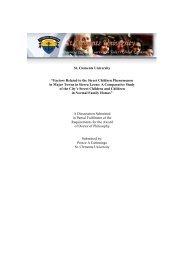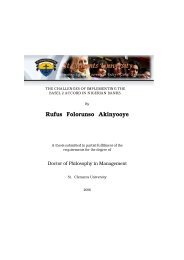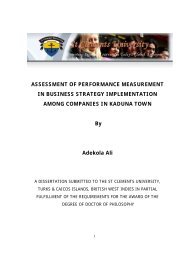The role of informal microfinance institutions in saving
The role of informal microfinance institutions in saving
The role of informal microfinance institutions in saving
You also want an ePaper? Increase the reach of your titles
YUMPU automatically turns print PDFs into web optimized ePapers that Google loves.
3.1.4 Methods <strong>of</strong> Data Collection and Sampl<strong>in</strong>g.<br />
Sampl<strong>in</strong>g<br />
Both probability and non-probability sampl<strong>in</strong>g will be employed <strong>in</strong> this study. <strong>The</strong> data<br />
collection process required a prelim<strong>in</strong>ary survey <strong>in</strong> order to construct the sampl<strong>in</strong>g frame and<br />
draw a sample. A pilot survey was conducted for this purpose. A population <strong>of</strong> small- scale<br />
enterprises <strong>in</strong> agricultural and non-agricultural activities was identified <strong>in</strong> the study region <strong>of</strong><br />
southern highland zone <strong>of</strong> Tanzania, with the help <strong>of</strong> the district <strong>of</strong>fices <strong>of</strong> the M<strong>in</strong>istry <strong>of</strong><br />
Agriculture, Market<strong>in</strong>g and Cooperatives. This <strong>in</strong>cluded both credit and non credit users. S<strong>in</strong>ce<br />
there is no <strong>of</strong>ficial register <strong>of</strong> <strong>in</strong>dividual entrepreneurs operat<strong>in</strong>g <strong>in</strong> these markets, it was not<br />
possible to have a list<strong>in</strong>g <strong>of</strong> the traders. Respondents were therefore randomly selected from<br />
this population <strong>in</strong> the selected markets us<strong>in</strong>g a random chart. Systematic random sampl<strong>in</strong>g was<br />
then used to pick subsequent respondents. <strong>The</strong> entrepreneurs were also used to identify the<br />
available <strong><strong>in</strong>formal</strong> sources <strong>of</strong> credit from which they had benefited. This was necessary <strong>in</strong><br />
order to avoid the problem <strong>of</strong> sample selection bias and also the possibility <strong>of</strong> <strong><strong>in</strong>formal</strong> lenders<br />
not known <strong>in</strong> the formal system.<br />
A sample size <strong>of</strong> 250 respondents was <strong>in</strong>itially targeted. However, only 170 respondents were<br />
successfully <strong>in</strong>terviewed, distributed as follows: Morogoro 47 respondents, Mbeya 63<br />
respondents, Dodoma 30 respondents, Ir<strong>in</strong>ga 23 respondents and Ruvuma 7 respondents.<br />
3.1.5: Data Collections<br />
Primary data was collected us<strong>in</strong>g both self-adm<strong>in</strong>istered and <strong>in</strong>terview methods. <strong>The</strong> primary<br />
data was collected us<strong>in</strong>g semi-structured and <strong>in</strong> depth <strong>in</strong>terviews. Semi-structured <strong>in</strong>terviews<br />
were undertaken by tak<strong>in</strong>g note <strong>of</strong> responses to a list <strong>of</strong> questions on the subject matter. <strong>The</strong><br />
follow<strong>in</strong>g key questions formed part <strong>of</strong> the questions asked dur<strong>in</strong>g semi-structured <strong>in</strong>terviews:<br />
• Who are the public and private sector support <strong><strong>in</strong>stitutions</strong> <strong>in</strong>volved with SACCOs<br />
development <strong>in</strong> Tanzania?<br />
• Are the support <strong><strong>in</strong>stitutions</strong> well equipped to deliver the services required by SACCOs?<br />
158
















